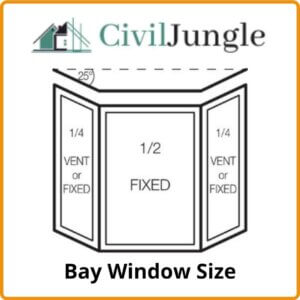
Introduction of Bay Window
Bay windows are generally a set of three or more windows that creates an outer angle beyond the exterior wall of a house. Bay windows can be of many shapes like square, hexagonal, octagonal, and so on.
Bay windows can largely be seen in the west. Mainly in Europe. But it can also be seen in other parts of the world. For instance, in Arab countries bay windows are largely present.
Bay windows are very beautiful and they can create a humongous difference in the outward looks of a mansion. Bay windows also make more space in the room so the room seems larger than it actually is.
What are Bay Windows?

The word bay comes from a French word ‘bae’ which means opening. In between the late 15th century and early 17th century during the English Renaissance period, Bay windows came into existence.
During this time bay windows were usually oriel type. These windows extend outwards from the wall but they do not touch the ground.
They were employed at the end of the great hall, at the opposite of the entrance, and behind a raised dais where the lord was served.
In the gothic era, bay windows are used as chapels in large churches and people could use them for personal worship In the Victorian era bay windows were a regular feature of newly built homes, mansions, churches, and various other architecture.
Architectural historian Randolph Delahanty wrote in his Victorian Sampler “bay windows were rare in the 1850s and 1860s but in 1870s they became universal.”
One angled, three sided Victorian bay window used to be usually 6 feet high and typically 2 to 3 feet outwards from the wall.
Type of Bay Windows
In the medieval period, bay windows were absolutely ornamental. But over the centuries architects did so many experiments with bay windows. As a result, Today there are numerous types of bay windows available all over the world.
Some of them are present in a myriad of numbers and some types are very rare but are of very unique design. The respective types of bay windows with pictures are described below.
1. Oriel Bay Windows

Being the oldest type of bay window, Oriel bay windows were first popularized during the English Renaissance period.
This type of bay window is basically construct at one side of a home. As mentioned earlier, bay windows do not touch the ground. So Oriel bay windows can be found on any floor of a building.
We need to use a decorative bracket or corbel of wood or stone is placed underneath the window for supporting purpose. Most of the oriel windows are 6m x 3m in size. But this size can vary.
2. Box Bay Windows

As per the name a box bay window is a kind of bay window which is shaped like a box. The shape of the box bay window is generally rectangular in shape. This type of bay window usually have flat sides with a flat roof and a flat front.
This kind of window can be found in a large number in the UK. Also in western Europe box bay windows can be seen in numbers.
The side of this type of window does not have an angled side. If the side is angled then it will be called a Canted bay window.
The depth of a bay window depends upon the angle it makes with the wall of the house. Most of the 30 degree bay windows are 12 to 14 inches deep.
If the angle of the window is 45 degrees then the range of the depth would be from 16 to 22 inches deep. Box bay windows are usually 18 to 24 inches deep.
3. Canted Bay Windows

Canted bay windows are very similar to Box bay windows. This type of bay window has the shape of an ideal classic bay window. This type of bay window has a flat front just like a Box bay window. But the sides of the window are angled.
Canted bay windows can be found only on the first floor or ground floor of a house or building. Canted bay windows are popular in Victorian style houses.
There can be three or four and sometimes even more than four different windows in a canted bay window.
4. Circle Bay Windows

Circle bay windows are the most evolved type of bay windows. Throughout the centuries architects have done so many experiments with bay windows. Thus the Circle bay windows came into existence.
This type of bay window is usually in a round shape. The result of combining several smaller windows in a single round shaped window is a Circle bay window. Circle bay windows are usually placed at the corner of a house.
Circle bay windows are bigger than Oriel bay windows and more ornamental than any other bay windows. This type of bay window is usually coupled with circular window seats which make the room more beautiful and elegant.
This type of bay window can be up to six feet high and may extend two or three feet outwards from the house.
5. Bow Bay Windows

This type of bay window is very useful for any scenic view outside. Bow bay windows have a curvature that sticks out of the house. Three or more casement windows are placed together in a line that gives a classic outward look to a house.
These types of bay windows do not touch the floor. So bow bay windows can be seen in not only on the ground floor but also on other floors as well.
Bow bay windows are larger than Oriel bay windows and Box bay windows and their purpose is different. With Bow bay windows you can get a larger view of the outside than normal windows.
Bay Window Size

Bay windows are made of three or four sometimes more than four windows. So the sizes of bay windows vary so much.
The size of a bay window depends on the house and the room it is built on. If it is a medium sized living room then the best dimension is an angle of 45 degrees and each window ranges from 16 inches to 36 inches.
If a bay window is incorporated with five windows with three in the middle and two on each side in an angled position then this size is usually 8 feet in length 6 feet high and 2 to 3 feet outwards the house.
One angle, three sided Victorian bay windows used to be usually 6 feet high and typically 2 to 3 feet outwards from the wall.
Most of the 30 degree bay windows are 12 to 14 inches deep. If the angle of the window is 45 degrees then the range of the depth would be from 16 to 22 inches deep. Box bay windows are usually 18 to 24 inches deep.
Most of the oriel windows are 6m x 3m in size. But this size can vary. The Circular bay windows windows can extend up to three feet and are usually six feet high.
Advantages and Disadvantages of Bay Window

Every beautiful thing comes with some advantages and sometimes with some disadvantages. Here some advantages and disadvantages of bay windows are mentioned below.
Advantages of Bay Window
Here, the pros of bay windows are as follows.
- Bay windows make a very beautiful and elegant outward appearance of a house. They represent the class of the owner. They add a one-of-a-kind to the overall look of the house and they provide superior functionality.
- Bay windows increase the value of a property to an unimaginable level. Beautiful windows in a straight line outside the house with traditional design and other ornaments simply increase the value of the house.
- The humongous sized windows automatically improve the lighting conditions of the room. Large windows let more lights in. And if colored glasses are used then the ambiance they create is impossible to avoid. This makes the room more gorgeous and creates impeccable beauty.
- These bay windows create more area inside your room making the room appear larger. They also create additional spaces where other ornaments, sitting couches, flower vases, etc. can be placed.
- From bay windows the owner can get an elaborated view of the outside. As the windows are larger in size so the viewing angle is more than that of the normal windows. So you can enjoy the scenic beauty outside a little more.
- Bay windows can give more views of the garden or the neighborhood
- The two sides of the bay window are usually not fixed although the middle part is. So the two sides which can be open and closed bring more ventilation to the room it is built on.
- They are beautiful, modern, and energy efficient.
Disadvantages of Bay Window
Here, the cons of bay windows are as follows.
- Bay windows are so expensive. And the maintenance is also more expensive than expected. So these kinds of windows are not for those who work on a limited budget. Added, bay windows are sometimes not replaceable. So they must be constructed during the construction of the house.
- Bigger space is good but sometimes more light is not what you want. In the summer more light can be disturbing as well. So in summer prone areas bay windows can be menacing.
- The maintenance of bay windows specially Oriel bay windows and Circle bay windows is not a piece of cake. It is not a do-it-yourself task. You will need a professional for the maintenance of the bay windows of your house.
FAQ: Bay Windows
What Is a Bay Window?
A bay window is a type of window that protrudes from the exterior wall of a building, creating a small alcove inside. It typically consists of three or more windows arranged to form a larger, angled space.
What Are the Different Types of Bay Windows?
Bay windows come in several styles, including:
- Oriel Bay Windows: Projecting from the wall but not touching the ground.
- Box Bay Windows: Rectangular with flat sides and a flat roof.
- Canted Bay Windows: Similar to box bay windows but with angled sides.
- Circle Bay Windows: Round, often with multiple smaller windows combined.
- Bow Bay Windows: Curved, providing a panoramic view with multiple casement windows.
What Is the History of Bay Windows?
Bay windows originated during the English Renaissance period between the late 15th and early 17th centuries. Initially, they were used in great halls and churches, evolving over time into a common feature in Victorian architecture and beyond.
What Are the Typical Sizes of Bay Windows?
The size of bay windows can vary widely. For example:
- Victorian Bay Windows: Typically 6 feet high and 2 to 3 feet outward from the wall.
- 30-Degree Bay Windows: Usually 12 to 14 inches deep.
- 45-Degree Bay Windows: Depth ranges from 16 to 22 inches.
- Circular Bay Windows: Can extend up to three feet and are usually six feet high.
What Are the Advantages of Bay Windows?
- Aesthetic Appeal: Bay windows enhance the exterior look of a home and add elegance.
- Increased Light: They allow more natural light into the room.
- Expanded Space: They create additional space inside, making rooms feel larger.
- Improved Views: They offer broader views of the outside.
- Ventilation: The design often allows for better airflow.
What Are the Disadvantages of Bay Windows?
- Cost: Bay windows can be expensive to install and maintain.
- Maintenance: Some types, like Oriel or Circle bay windows, require professional upkeep.
- Overexposure: In sunny climates, they may let in too much light and heat.
- Replacement Issues: They are often integrated into the building structure and may not be easily replaced.
Can Bay Windows Be Installed in Any Type of Building?
Bay windows can be installed in most buildings, but their suitability depends on the architectural style and structural considerations of the home. They are most commonly seen in older or traditional styles but can be adapted for modern designs.
How Do I Maintain Bay Windows?
Maintenance varies by type:
- Oriel and Circle Bay Windows: Regularly check for leaks and wear on decorative supports. Professional maintenance may be required.
- Box and Canted Bay Windows: Ensure that the angles and joints are properly sealed and free from damage.

